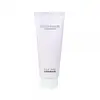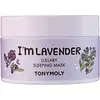What's inside
What's inside
 Key Ingredients
Key Ingredients

 Benefits
Benefits

 Concerns
Concerns

 Ingredients Side-by-side
Ingredients Side-by-side

Water
Skin ConditioningGlycerin
HumectantCyclopentasiloxane
EmollientCyclohexasiloxane
EmollientButylene Glycol
HumectantCetearyl Isononanoate
EmollientCetearyl Alcohol
EmollientDimethicone
EmollientPolysorbate 60
EmulsifyingMilk Protein Extract
Lavandula Angustifolia Extract
Skin ConditioningStearic Acid
CleansingGlyceryl Stearate
EmollientPEG-100 Stearate
Sorbitan Stearate
EmulsifyingSilica
AbrasiveButyrospermum Parkii Butter
Skin ConditioningCeramide AP
Skin Conditioning1,2-Hexanediol
Skin ConditioningAmmonium Acryloyldimethyltaurate/Vp Copolymer
Caprylyl Glycol
EmollientLavandula Angustifolia Oil
MaskingAllantoin
Skin ConditioningDimethicone/PEG-10/15 Crosspolymer
Ethylhexylglycerin
Skin ConditioningDipotassium Glycyrrhizate
HumectantSalicylic Acid
MaskingPentylene Glycol
Skin ConditioningAspalathus Linearis Extract
Skin ConditioningGlycyrrhiza Glabra Root Extract
BleachingGlycine
BufferingSerine
MaskingGlutamic Acid
HumectantYucca Schidigera Root Extract
Skin ConditioningCommiphora Myrrha Resin Extract
Skin ConditioningPerilla Frutescens Leaf Extract
MaskingAspartic Acid
MaskingLeucine
Skin ConditioningAlanine
MaskingLysine
Skin ConditioningArginine
MaskingTyrosine
MaskingPhenylalanine
MaskingValine
MaskingThreonine
Proline
Skin ConditioningIsoleucine
Skin ConditioningHistidine
HumectantMethionine
Skin ConditioningCysteine
AntioxidantCI 17200
Cosmetic ColorantCI 42090
Cosmetic ColorantLinalool
PerfumingGeraniol
PerfumingLimonene
PerfumingWater, Glycerin, Cyclopentasiloxane, Cyclohexasiloxane, Butylene Glycol, Cetearyl Isononanoate, Cetearyl Alcohol, Dimethicone, Polysorbate 60, Milk Protein Extract, Lavandula Angustifolia Extract, Stearic Acid, Glyceryl Stearate, PEG-100 Stearate, Sorbitan Stearate, Silica, Butyrospermum Parkii Butter, Ceramide AP, 1,2-Hexanediol, Ammonium Acryloyldimethyltaurate/Vp Copolymer, Caprylyl Glycol, Lavandula Angustifolia Oil, Allantoin, Dimethicone/PEG-10/15 Crosspolymer, Ethylhexylglycerin, Dipotassium Glycyrrhizate, Salicylic Acid, Pentylene Glycol, Aspalathus Linearis Extract, Glycyrrhiza Glabra Root Extract, Glycine, Serine, Glutamic Acid, Yucca Schidigera Root Extract, Commiphora Myrrha Resin Extract, Perilla Frutescens Leaf Extract, Aspartic Acid, Leucine, Alanine, Lysine, Arginine, Tyrosine, Phenylalanine, Valine, Threonine, Proline, Isoleucine, Histidine, Methionine, Cysteine, CI 17200, CI 42090, Linalool, Geraniol, Limonene
Water
Skin ConditioningGlycerin
HumectantDimethicone
EmollientButylene Glycol
HumectantCaprylic/Capric Triglyceride
MaskingDipropylene Glycol
HumectantGlycereth-26
HumectantSorbitan Stearate
EmulsifyingDicaprylyl Carbonate
EmollientCetyl PEG/PPG-10/1 Dimethicone
EmulsifyingDimethicone/PEG-10/15 Crosspolymer
Dimethicone/Vinyl Dimethicone Crosspolymer
Skin ConditioningPEG-100 Stearate
Cetearyl Alcohol
EmollientCetearyl Stearate
Skin ConditioningGlyceryl Stearate
EmollientCyclomethicone
EmollientLavandula Angustifolia Flower Water
Skin ConditioningJasminum Officinale Flower Water
MaskingChamomilla Recutita Flower Water
MaskingRosa Centifolia Flower Water
Skin ConditioningHamamelis Virginiana Water
AstringentRosmarinus Officinalis Leaf Water
MaskingMentha Piperita Leaf Water
Skin ConditioningNelumbium Speciosum Flower Extract
Skin ConditioningGossypium Herbaceum Extract
Skin ConditioningEclipta Prostrata Extract
Skin ConditioningBrassica Napus Extract
Skin ConditioningCorallina Officinalis Extract
Skin ConditioningCamellia Japonica Flower Extract
EmollientCananga Odorata Flower Extract
PerfumingHibiscus Sabdariffa Flower Extract
Skin ConditioningAloe Barbadensis Flower Extract
EmollientCalendula Officinalis Flower Extract
MaskingMelia Azadirachta Flower Extract
Skin ConditioningOcimum Sanctum Leaf Extract
Skin ConditioningMentha Rotundifolia Leaf Extract
TonicMelia Azadirachta Leaf Extract
Skin ConditioningSolanum Melongena Fruit Extract
Skin ConditioningCoccinia Indica Fruit Extract
Skin ConditioningMagnolia Kobus Bark Extract
Skin ConditioningCurcuma Longa Root Extract
MaskingLavandula Angustifolia Oil
MaskingSimmondsia Chinensis Seed Oil
EmollientMoringa Oleifera Seed Oil
EmollientSodium Carbomer
Emulsion StabilisingXanthan Gum
Emulsifying1,2-Hexanediol
Skin ConditioningHydroxyacetophenone
AntioxidantEthylhexylglycerin
Skin ConditioningDisodium EDTA
Water, Glycerin, Dimethicone, Butylene Glycol, Caprylic/Capric Triglyceride, Dipropylene Glycol, Glycereth-26, Sorbitan Stearate, Dicaprylyl Carbonate, Cetyl PEG/PPG-10/1 Dimethicone, Dimethicone/PEG-10/15 Crosspolymer, Dimethicone/Vinyl Dimethicone Crosspolymer, PEG-100 Stearate, Cetearyl Alcohol, Cetearyl Stearate, Glyceryl Stearate, Cyclomethicone, Lavandula Angustifolia Flower Water, Jasminum Officinale Flower Water, Chamomilla Recutita Flower Water, Rosa Centifolia Flower Water, Hamamelis Virginiana Water, Rosmarinus Officinalis Leaf Water, Mentha Piperita Leaf Water, Nelumbium Speciosum Flower Extract, Gossypium Herbaceum Extract, Eclipta Prostrata Extract, Brassica Napus Extract, Corallina Officinalis Extract, Camellia Japonica Flower Extract, Cananga Odorata Flower Extract, Hibiscus Sabdariffa Flower Extract, Aloe Barbadensis Flower Extract, Calendula Officinalis Flower Extract, Melia Azadirachta Flower Extract, Ocimum Sanctum Leaf Extract, Mentha Rotundifolia Leaf Extract, Melia Azadirachta Leaf Extract, Solanum Melongena Fruit Extract, Coccinia Indica Fruit Extract, Magnolia Kobus Bark Extract, Curcuma Longa Root Extract, Lavandula Angustifolia Oil, Simmondsia Chinensis Seed Oil, Moringa Oleifera Seed Oil, Sodium Carbomer, Xanthan Gum, 1,2-Hexanediol, Hydroxyacetophenone, Ethylhexylglycerin, Disodium EDTA
Ingredients Explained
These ingredients are found in both products.
Ingredients higher up in an ingredient list are typically present in a larger amount.
1,2-Hexanediol is a synthetic liquid and another multi-functional powerhouse.
It is a:
- Humectant, drawing moisture into the skin
- Emollient, helping to soften skin
- Solvent, dispersing and stabilizing formulas
- Preservative booster, enhancing the antimicrobial activity of other preservatives
Butylene Glycol (or BG) is used within cosmetic products for a few different reasons:
Overall, Butylene Glycol is a safe and well-rounded ingredient that works well with other ingredients.
Though this ingredient works well with most skin types, some people with sensitive skin may experience a reaction such as allergic rashes, closed comedones, or itchiness.
Learn more about Butylene GlycolCetearyl alcohol is a mixture of two fatty alcohols: cetyl alcohol and stearyl alcohol. It is mainly used as an emulsifier. Emulsifiers help prevent the separation of oils and products. Due to its composition, it can also be used to thicken a product or help create foam.
Cetearyl alcohol is an emollient. Emollients help soothe and hydrate the skin by trapping moisture.
Studies show Cetearyl alcohol is non-toxic and non-irritating. The FDA allows products labeled "alcohol-free" to have fatty alcohols.
This ingredient is usually derived from plant oils such as palm, vegetable, or coconut oils. There is debate on whether this ingredient will cause acne.
Due to the fatty acid base, this ingredient may not be Malassezia folliculitis safe.
Learn more about Cetearyl AlcoholDimethicone is a type of synthetic silicone created from natural materials such as quartz.
What it does:
Dimethicone comes in different viscosities:
Depending on the viscosity, dimethicone has different properties.
Ingredients lists don't always show which type is used, so we recommend reaching out to the brand if you have questions about the viscosity.
This ingredient is unlikely to cause irritation because it does not get absorbed into skin. However, people with silicone allergies should be careful about using this ingredient.
Note: Dimethicone may contribute to pilling. This is because it is not oil or water soluble, so pilling may occur when layered with products. When mixed with heavy oils in a formula, the outcome is also quite greasy.
Learn more about DimethiconeDimethicone/PEG-10/15 Crosspolymer is a type of silicone.
Ethylhexylglycerin (we can't pronounce this either) is commonly used as a preservative and skin softener. It is derived from glyceryl.
You might see Ethylhexylglycerin often paired with other preservatives such as phenoxyethanol. Ethylhexylglycerin has been found to increase the effectiveness of these other preservatives.
Glycerin is already naturally found in your skin. It helps moisturize and protect your skin.
A study from 2016 found glycerin to be more effective as a humectant than AHAs and hyaluronic acid.
As a humectant, it helps the skin stay hydrated by pulling moisture to your skin. The low molecular weight of glycerin allows it to pull moisture into the deeper layers of your skin.
Hydrated skin improves your skin barrier; Your skin barrier helps protect against irritants and bacteria.
Glycerin has also been found to have antimicrobial and antiviral properties. Due to these properties, glycerin is often used in wound and burn treatments.
In cosmetics, glycerin is usually derived from plants such as soybean or palm. However, it can also be sourced from animals, such as tallow or animal fat.
This ingredient is organic, colorless, odorless, and non-toxic.
Glycerin is the name for this ingredient in American English. British English uses Glycerol/Glycerine.
Learn more about GlycerinGlyceryl Stearate is a mix of glycerin and stearic acid.
It is used to stabilize the mixing of water and oil ingredients. By preventing these ingredients from separating, it can help elongate shelf life. It can also help thicken the product's texture.
As an emollient, it helps soften skin and supports barrier-replenishing ingredients.
In cosmetics, Glyceryl Stearate is often made from vegetable oils or synthetically produced.
This ingredient may not be fungal-acne safe
Fun fact: The human body also creates Glyceryl Stearate naturally.
Learn more about Glyceryl StearateLavandula Angustifolia Oil is more commonly known as lavender essential oil. It is considered a fragrancing ingredient.
Lavender imparts a famous scent. While the smell is lovely, this ingredient and may sensitize skin in topical products. This is because about 85% of the oil is made up of linalool and linalyl acetate.
When exposed to air, these two compounds become strong allergens. This ingredient exhibits cytotoxicity at low concentrations; amounts of 0.25% have been shown to damage skin cells.
A study from Japan found this ingredient caused lavender sensitivity after widespread exposure.
Lavender essential oil has some antimicrobial, antibacterial, and anti-inflammatory properties. However, the cons of this ingredient may outweight the pros.
More research is needed to confirm lavender essential oil's effects when used in aromatherapy.
Lavandula Angustifolia is known as the English Lavender and famous for creating purple fields in Provence, France.
Learn more about Lavandula Angustifolia OilPeg-100 Stearate is an emollient and emulsifier. As an emollient, it helps keep skin soft by trapping moisture in. On the other hand, emulsifiers help prevent oil and water from separating in a product.
PEGS are a hydrophilic polyether compound . There are 100 ethylene oxide monomers in Peg-100 Stearate. Peg-100 Stearate is polyethylene glycol ester of stearic acid.
Sorbitan Stearate comes from sorbitol and stearic acid. Sorbitol is a type of sugar and stearic acid is a fatty acid.
It is used as an emulsifier and helps ingredients stay together by creating water-in-oil emulsions.
This ingredient may not be Malassezia folliculitis, or fungal-acne safe.
Water. It's the most common cosmetic ingredient of all. You'll usually see it at the top of ingredient lists, meaning that it makes up the largest part of the product.
So why is it so popular? Water most often acts as a solvent - this means that it helps dissolve other ingredients into the formulation.
You'll also recognize water as that liquid we all need to stay alive. If you see this, drink a glass of water. Stay hydrated!
Learn more about Water